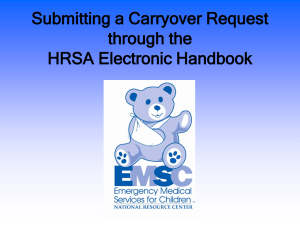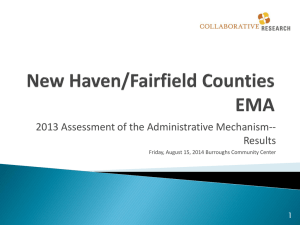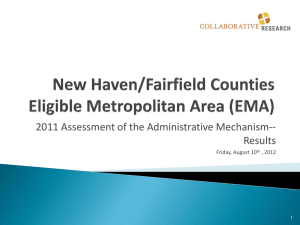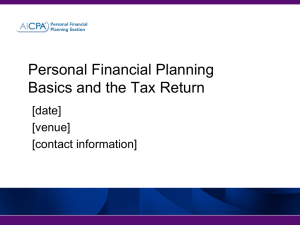Carryover (accessible version) [MS Word Document
advertisement
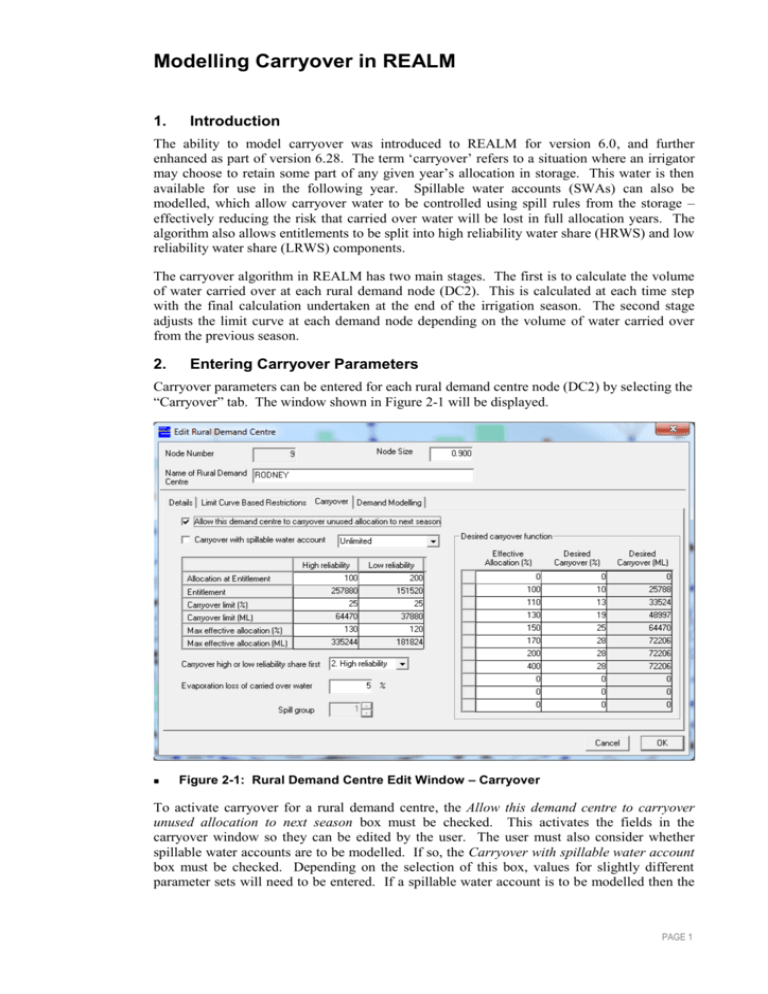
Modelling Carryover in REALM 1. Introduction The ability to model carryover was introduced to REALM for version 6.0, and further enhanced as part of version 6.28. The term ‘carryover’ refers to a situation where an irrigator may choose to retain some part of any given year’s allocation in storage. This water is then available for use in the following year. Spillable water accounts (SWAs) can also be modelled, which allow carryover water to be controlled using spill rules from the storage – effectively reducing the risk that carried over water will be lost in full allocation years. The algorithm also allows entitlements to be split into high reliability water share (HRWS) and low reliability water share (LRWS) components. The carryover algorithm in REALM has two main stages. The first is to calculate the volume of water carried over at each rural demand node (DC2). This is calculated at each time step with the final calculation undertaken at the end of the irrigation season. The second stage adjusts the limit curve at each demand node depending on the volume of water carried over from the previous season. 2. Entering Carryover Parameters Carryover parameters can be entered for each rural demand centre node (DC2) by selecting the “Carryover” tab. The window shown in Figure 2-1 will be displayed. Figure 2-1: Rural Demand Centre Edit Window – Carryover To activate carryover for a rural demand centre, the Allow this demand centre to carryover unused allocation to next season box must be checked. This activates the fields in the carryover window so they can be edited by the user. The user must also consider whether spillable water accounts are to be modelled. If so, the Carryover with spillable water account box must be checked. Depending on the selection of this box, values for slightly different parameter sets will need to be entered. If a spillable water account is to be modelled then the PAGE 1 user also needs to select whether transfer of carryover volume in excess of entitlements to SWAs is limited or unlimited using the adjacent drop-down box. To specify the point on the limit curve defining high and low reliability water shares, the user should enter percentage allocations into the Allocation at Entitlement fields. If the limit curve has been completed (in the “Limit Curve Based Restrictions” tab), the dialog box will automatically calculate the volume of water at each allocation in the Entitlement fields. These fields cannot be edited by the user – they are intended as a check to ensure that the correct allocations have been entered. Note: in order to ensure that all functionality within the carryover window is active, it is strongly recommended that the limit curve be defined for the rural demand centre before carryover parameters are entered. The user may wish to specify the maximum amount of water that can be carried over. This is done by entering percentages in the Carryover limit (%) fields. These limits refer to limits on carryover volume when no SWAs are modelled and limits on transfer of carryover volume in excess of entitlements to SWAs when limited SWAs are modelled. Once again, the dialog box will automatically convert these percentages into volumes via the limit curve in the Carryover limit (ML) fields. This field is not required if unlimited spillable water accounts are to be modelled. The maximum effective allocation is the highest allocation that can be provided in the season following a carryover. This is specified in the Max effective allocation (%) fields. The equivalent volume is automatically calculated from the limit curve and placed in the Max effective allocation (ML) fields. This field is not required if spillable water accounts are to be modelled. Users can specify whether the high or low reliability water share is carried over first by changing the option selected in the Carryover high or low reliability share first drop down box. This field is not required if spillable water accounts are to be modelled. The percentage of the carried over water lost to evaporation is specified in the Evaporation loss of carried over water field. If spillable water accounts are to be modelled, the user must also enter a spill group for this demand node in the Spill group field. Each spill group also requires that variable capacity carriers be defined which control the spill trigger and spill volume for that group. These carriers are specified in the Spill groups dialogue box which is accessed via the Edit -> Spill groups menu selection or the toolbar button. The user must also define the carryover function. The carryover function indicates how much water irrigators will choose to carryover depending on the effective allocation for that season. Similar to the limit curve, the user should enter percentage allocation values into the Allocation (%) field, and percentage carryover values into the Carryover (%) field. The dialog box automatically calculates a volume for each allocation in the Carryover (ML) field by referencing the limit curve. The carryover function should be derived from observed or theoretical irrigator behaviour. An example carryover function is shown in Figure 2-2, from which it can be seen that 5% of the allocation is carried over for allocations between 10% and 60%. At low allocations, the irrigator is likely to carryover some water to provide a potential supply in case of an even lower allocation season next year. As the allocation rises, the irrigator is likely to commit a greater percentage to carryover and thus create additional flexibility for the following season. PAGE 2 25 Carryover (%) 20 15 10 5 0 0 20 40 60 80 100 120 140 160 180 200 Allocation (%) 3. Figure 2-2: Example Carryover Function Carryover Algorithm The carryover algorithm is documented as a number of steps. Step 1: If SWAs are modelled, irrigators do not lose water once their total allocation (carryover and current season allocation) reaches 100% of their entitlement volume. Instead, the total allocation in excess of 100% of their entitlement volume is transferred to SWAs. If SWAs are not modelled, this volume in excess of the maximum effective allocation (ie allowable total allocation) is lost. At each time step of current season, the total allocation volume to be transferred to SWAs is calculated as below: 𝑉𝑆𝑊𝐴 = 0 - if SWAs not modelled 𝑉𝑆𝑊𝐴 = 𝑚𝑎𝑥𝑖𝑚𝑢𝑚[((𝐴𝐶𝑡−1 + 𝐴ℎ + 𝐴𝑙 ) − (𝐸ℎ + 𝐸𝑙 )), 0] - if SWAs modelled Where: VSWA ACt-1 Ah = Total allocation volume transferred to SWA (ML) = Total actual carryover at end of last season (ML) = Current season HRWS allocation (ML), calculated at end of last time step Al = Current season LRWS allocation (ML) , calculated at end of last time step Eh El = HRWS entitlement (ML) = LRWS entitlement (ML) PAGE 3 Step 2: Water in SWAs is not available for irrigators until the storage operator declares that there is an acceptable risk of the system spilling for rest of the season. When the system is declared to not spill for rest of the season, then water in SWAs is transferred to irrigators’ allocation bank account and they can use it. This is modelled by introducing a variable referred as spill trigger for SWA (TSWA). The spill trigger for SWA (TSWA) is input or calculated in the model as 0’s and 1’s through type 3 carrier, 0’s when the system is declared to not spill for rest of the season and 1’s when the risk of spill is still unacceptable. Then allocations available for use (ML) at each time step of current season are calculated as follows. 𝐴𝑒ℎ = 𝑚𝑖𝑛𝑖𝑚𝑢𝑚[𝐴𝑒ℎ𝑚 , (𝐴𝐶ℎ−1 + 𝐴ℎ )] 𝐴𝑒𝑙 = 𝑚𝑖𝑛𝑖𝑚𝑢𝑚[𝐴𝑒𝑙𝑚 , (𝐴𝐶𝑙−1 + 𝐴𝑙 )] 𝐴𝑒𝑡 = 𝐴𝐶𝑡−1 + 𝐴ℎ + 𝐴𝑙 − 𝑉𝑆𝑊𝐴 + 𝑉𝑆𝑊𝐴 × 𝑎𝑏𝑠(𝑇𝑆𝑊𝐴 − 1) Where: Aeh Ael Aet Aehm Aelm ACh-1 ACl-1 Ah Al TSWA - if SWAs not modelled - if SWAs modelled = Available HRWS allocation for use (ML) = Available LRWS allocation for use (ML) = Available total allocation for use (ML) = Maximum effective HRWS allocation (ML) = Maximum effective LRWS allocation (ML) = Actual HRWS carryover at end of last season (ML) = Actual LRWS carryover at end of last season (ML) = Current season HRWS allocation (ML) = Current season LRWS allocation (ML) = Spill trigger for SWA Step 3: Effective allocations in ML (Ae ML) at each time step of current season is calculated as below. 𝐴𝑒 𝑀𝐿 = 𝐴𝑒ℎ + 𝐴𝑒𝑙 + 𝐴𝑜,𝑡−1 - if SWAs not modelled 𝐴𝑒 𝑀𝐿 = 𝐴𝑒𝑡 + 𝐴𝑜,𝑡−1 - if SWAs modelled Where: Ae ML Ao,t-1 = Effective allocation (ML) = Off-quota allocation at previous time step (ML) Step 4: Effective allocations in % (Ae %) corresponding to effective allocations in ML (Ae ML) from Step 3 is calculated from unadjusted limit curves, i.e. the volume of HRWS and LRWS entitlements in each demand. Step 5: Desired carryover function is an input which describes the volume irrigators plan to carryover as function of seasonal allocation. Then desired carryover, DC at each time step of current season is calculated as follows. DC = Desired carryover value from carryover function (ML). Note that it is based on the effective allocation, i.e. current season allocation plus total accessible carryover volume and off-quota allocation (ML). PAGE 4 Step 6: At each time step of current season, annual limits (ML) are adjusted for desired carryover as below. 𝐴𝐴𝐿 = 𝐴𝑒 𝑀𝐿 − 𝐷𝐶 Where: AAL = Adjusted annual limit (ML) It should be noted that Steps 1 to 6 are undertaken in each time step before the network linear program is solved. Steps 7 onwards are undertaken in each time step after the network linear program has reached convergence. For further clarification please refer to Appendix A. Step 7: This step is relevant only when SWA is available. If the designated storage spills, the water in SWAs spills proportionately. The SWAs are accordingly adjusted for spills. For this purpose, two variables are introduced as follows. Spill group – The user needs to specify a unique spill group number (1, 2, 3 …etc.) for all demands in the system which is spilling. For example, all demands in the Goulburn system for which the spill from Eildon applies, are assigned same spill group number. Spill volume – For each demand node, the user needs to specify a type 3 carrier which tracks the spill volume applicable for the spill group. It is required that same carrier is specified for all nodes in the same spill group. For this purpose, at least a check is included such that user is alerted when different carriers are specified for demand nodes in the same spill group, if not a better approach could be adopted. At each time step of current season, the SWAs are not required to be adjusted if the spill trigger, TSWA (refer to step 2 for details) is equal to 0. If TSWA equals to 1, the SWAs are adjusted for spills as follows. Δ𝑆𝑊𝐴 𝑖 = 0 - if SWAs not modelled 𝑉𝑉𝑆𝑊𝐴 𝑖 = 0 If SWAs modelled: 𝑉𝑆𝑊𝐴 𝑖 𝑖=1 𝑉𝑆𝑊𝐴 𝑖 Δ𝑆𝑊𝐴 𝑖 = 𝑚𝑖𝑛𝑖𝑚𝑢𝑚[𝑉𝑠 , ∑𝑛𝑖=1 𝑉𝑆𝑊𝐴 𝑖 ] × ∑𝑛 TSWA = 1(July) 𝑉𝑆𝑊𝐴 𝑖 𝑖=1 𝑉𝑆𝑊𝐴 𝑖 Δ𝑆𝑊𝐴 𝑖 = 𝑚𝑖𝑛𝑖𝑚𝑢𝑚[(𝑉𝑠 + ∑𝑛𝑖=1 Δ𝑆𝑊𝐴 𝑖,𝑡−1 ), ∑𝑛𝑖=1 𝑉𝑆𝑊𝐴 𝑖 ] × ∑𝑛 TSWA = 1(all other months) Δ𝑆𝑊𝐴 𝑖 = 0 TSWA = 0(July) Δ𝑆𝑊𝐴 𝑖 = Δ𝑆𝑊𝐴 𝑖,𝑡−1 TSWA = 0(all other months) VV𝑆𝑊𝐴 𝑖 = 𝑉𝑆𝑊𝐴 𝑖 − Δ𝑆𝑊𝐴 𝑖 Where: ΔSWA i VVSWA i VSWA i Vs n = System spill adjustment to SWA of demand i (ML) = Adjusted SWA of demand i (ML) = Total allocation volume transferred to SWA of demand i (ML) = Total system spill volume from July to date for the spill group (ML) = Number of demands in the spill group PAGE 5 Step 8: Unused allocation at each time step of current season is calculated as follows. 𝐴𝑢 = [(𝐴𝐴𝐿 − 𝑈) + 𝐷𝐶] - if SWAs not modelled 𝐴𝑢 = [((𝐴𝐴𝐿 − 𝑈) + 𝐷𝐶) + (𝑉𝑉𝑆𝑊𝐴 𝑖 × 𝑇𝑆𝑊𝐴 )] - if SWAs modelled Where: Au U = Unused allocation (ML) = Use to date (ML) Step 9: Evaporation loss for carryover, EL% (%) is an input and used to estimate evaporation loss for carryover in ML (ELML) as follows. In June: 𝐸𝐿 𝐸𝐿𝑀𝐿 = 𝑚𝑖𝑛𝑖𝑚𝑢𝑚[𝐴𝑢 , (𝐶𝐿ℎ + 𝐶𝐿𝑙 )] × 100% 𝐸𝐿𝑀𝐿 = 𝐴𝑢 × - if SWAs not modelled 𝐸𝐿% 100 - if SWAs modelled (unlimited carryover) 𝐸𝐿 𝐸𝐿𝑀𝐿 = 𝑚𝑖𝑛𝑖𝑚𝑢𝑚[𝐴𝑢 , (𝐶𝐿𝑆𝑊𝐴 ℎ + 𝐶𝐿𝑆𝑊𝐴 𝑙 )] × 100% - if SWAs modelled (limited carryover) In all other months: 𝐸𝐿𝑀𝐿 = 0 Where: ELML CLh CLl EL% CLSWA h CLSWA l = Evaporation loss for carryover (ML) = High Reliability Water Share (HRWS) carryover limit (ML) = Low Reliability Water Share (LRWS) carryover limit (ML) = Evaporation loss for carryover (%) = High Reliability Water Share (HRWS) carryover limit for SWA (ML) = Low Reliability Water Share (LRWS) carryover limit for SWA (ML) Step 10: Total actual carryover, ACt (ML) at each time step of current season is calculated as follows. In June: 𝐴𝐶𝑡 = 𝑚𝑖𝑛𝑖𝑚𝑢𝑚[𝐴𝑢 , (𝐶𝐿ℎ + 𝐶𝐿𝑙 )] − 𝐸𝐿𝑀𝐿 - if SWAs not modelled 𝐴𝐶𝑡 = 𝐴𝑢 − 𝐸𝐿𝑀𝐿 - if SWAs modelled (unlimited carryover) 𝐴𝐶𝑡 = 𝑚𝑖𝑛𝑖𝑚𝑢𝑚[𝐴𝑢 , (𝐶𝐿𝑆𝑊𝐴 ℎ + 𝐶𝐿𝑆𝑊𝐴 𝑙 )] − 𝐸𝐿𝑀𝐿 - if SWAs modelled (limited carryover) In all other months: 𝐴𝐶𝑡 = 𝐴𝐶𝑡,𝑡−1 Where: ACt = Total actual carryover at end of current season (ML) PAGE 6 ACt,t-1 = Total actual carryover value at previous time step (ML) (Note: this is different from ACt-1) Step 11: At end of current season (June), total actual carryover, ACt (ML) from Step 10 is total of HRWS and LRWS carryovers. If SWAs are not modelled, it is required to be split into actual HRWS (ACh) and LRWS (ACl) carryovers. How it is done depends on whether the user specified HRWS or LRWS bucket to be used first. If the LRWS bucket is filled first, then actual HRWS (ACh) and LRWS (ACl) carryovers (ML) are calculated as follows. 𝐴𝐶𝑙 = 𝑚𝑖𝑛𝑖𝑚𝑢𝑚 [((1 − 𝐸𝐿% )× 100 𝐶𝐿𝑙 ) , 𝐴𝐶𝑡 ] 𝐴𝐶𝑙 = 𝐴𝐶𝑙,𝑡−1 - June - July - May 𝐴𝐶ℎ = 𝑚𝑖𝑛𝑖𝑚𝑢𝑚 [((1 − 𝐸𝐿% )× 100 𝐶𝐿ℎ ) , (𝐴𝐶𝑡 − 𝐴𝐶𝑙 )] 𝐴𝐶ℎ = 𝐴𝐶ℎ,𝑡−1 - June - July - May If the HRWS bucket is filled first, then actual HRWS (ACh) and LRWS (ACl) carryovers (ML) are calculated as follows. 𝐴𝐶ℎ = 𝑚𝑖𝑛𝑖𝑚𝑢𝑚 [((1 − 𝐸𝐿% )× 100 𝐶𝐿ℎ ) , 𝐴𝐶𝑡 ] - June - July – May 𝐴𝐶ℎ = 𝐴𝐶ℎ,𝑡−1 𝐸𝐿 𝐴𝐶𝑙 = 𝑚𝑖𝑛𝑖𝑚𝑢𝑚 [((1 − 100% ) × 𝐶𝐿𝑙 ) , (𝐴𝐶𝑡 − 𝐴𝐶ℎ )] - June 𝐴𝐶𝑙 = 𝐴𝐶𝑙,𝑡−1 - July - May If SWAs are modelled, the total actual carryover, ACt is not required to be split into actual HRWS (ACh) and LRWS (ACl) carryovers and therefore this step is not relevant. Where: ACh ACl ACh,t-1 ACl,t-1 = Actual HRWS carryover at end of current season (ML) = Actual LRWS carryover at end of current season (ML) = Actual HRWS carryover value at previous time step (ML) (Note: this is different from ACh-1) = Actual HRWS carryover value at previous time step (ML) (Note: this is different from ACl-1) PAGE 7 4. Carryover Output A number of additional system variables were introduced with carryover to allow various carryover parameters to be referenced in carrier equations and thus used in different parts of the model. These are shown in Table 4-1. Table 4-1: Available Carryover System Variables for Variable Capacity Carrier Modelling Variable Name Node name Sub-group Rural demand (DC2) Type Description Variable Name and Type DCVR Desired carryover (ML) RODNEY and LALL ATCV Total actual carryover (ML) CVRH Actual high reliability share carryover (ML) CVRL Actual low reliability share carryover (ML) LALL Adjusted low reliability share limit (ML) HALL Adjusted high reliability share limit (ML) CEVP Volume of carried over water lost to evaporation (ML) VSWA Total volume transferred into spillable water account (ML) AVSW Adjusted spillable water account (ML) SWAL Available allocation (ML) ADJL Adjusted limit (ML) ALML Effective allocation (ML) ALVL Effective allocation (%) -ACV Total actual carryover from previous time step (ML) Type Remarks RODNEY is a rural demand node (DC2) name in the system file PAGE 8 Variable Name Sub-group Type Type Description -ACH Actual high reliability share carryover from previous time step(ML) -ACL Actual low reliability share carryover from previous time step (ML) Variable Name and Type Remarks Appendix A: Available information at start of time step: Eh, El, CLh, CLl, CLSWA h, CLSWA l, EL%, Ao, Aehm, Aelm, Ah, Al, ACt-1, ACh-1 and ACl-1 Beginning Simulation/ Convergence End Current Simulation Time Step Calculation Steps Carryover with SWA Rule Carryover without SWA Rule Step 1 VSWA = f(ACt-1, Ah, Al, Eh, El) N/A Step 2 TSWA = f(STOR)/User define Aet = f(ACt-1, Ah, Al, VSWA, TSWA) Aeh = f(Aehm, ACh-1, Ah) Ael = f(Aelm, ACl-1, Al) Step 3 AeML = f(Aet, Ao, t-1) AeML = f(Aeh, Ael, Ao, t-1) Step 4 Ae% = f(AeML, Limit curve) Ae% = f(AeML, Limit curve) Step 5 DC = f(Ae%, Carryover function) DC = f(Ae%, Carryover function) Step 6 AAL = f(AeML, DC) AAL = f(AeML, DC) Available information after simulation/Convergence: Vs, U Step 7 ΔSWA = f(Vs, VSWA) VVSWA = f(VSWA, ΔSWA) N/A PAGE 9 Step 8 Au = f(AAL, U, DC, VVSWA, TSWA) Au = f(AAL, U, DC) For SWAs with unlimited carryover: ELML = f(Au, EL%) Step 9 For SWAs with limited carryover: ELML = f(Au, CLSWA h, CLSWA l, EL%) ELML = f(Au, CLh, CLl, EL%) For SWAs with unlimited carryover: ACt = f(Au, ELML) Step 10 For SWAs with limited carryover ACt = f(Au, CLSWA h, CLSWA l, ELML) ACt = f(Au, CLh, CLl, ELML) If LRWS bucket fill first: ACl = f(EL%, CLl, ACt) ACh = f(EL%, CLh, ACt, ACl) Step 11 N/A If HRWS bucket fill first: ACh = f(EL%, CLh, ACt) ACl = f(EL%, CLl, ACt, ACh) PAGE 10
